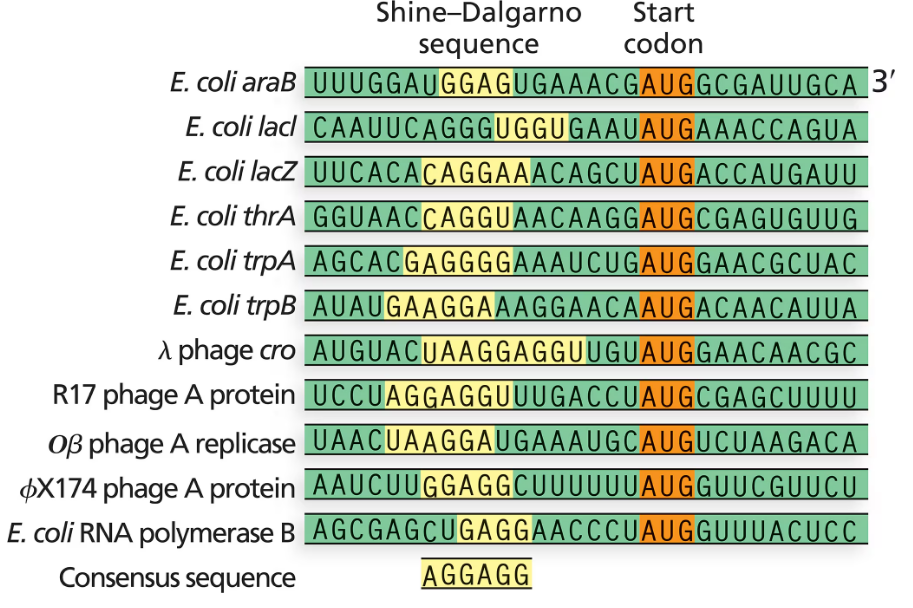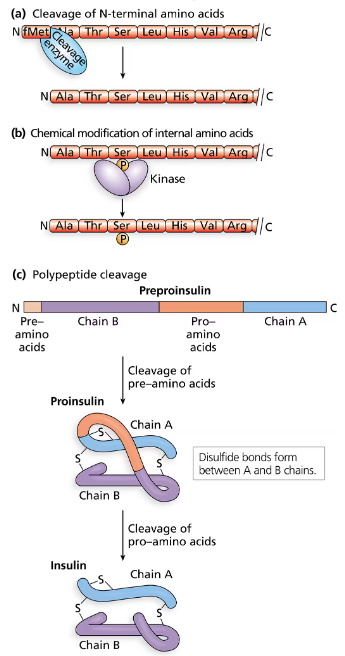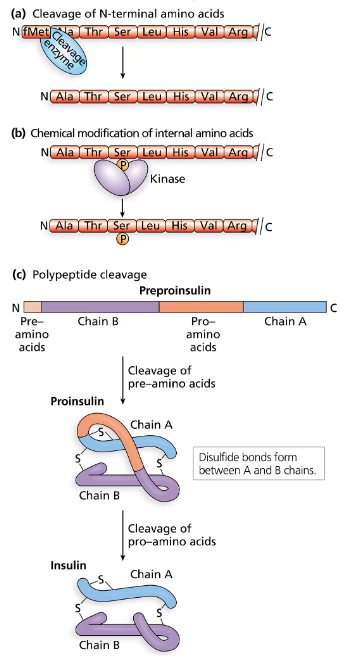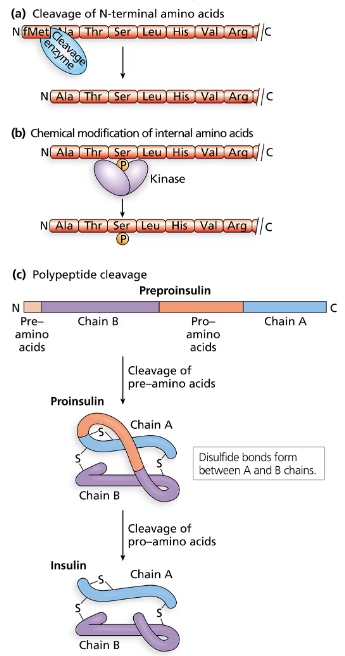 Back
BackProblem 19
Define and describe the differences in the primary, secondary, and tertiary structures of a protein.
Problem 20a
Describe the roles and relationships between tRNA synthetases and tRNA molecules.
Problem 20b
Describe the roles and relationships between tRNA anticodon sequences and mRNA codon sequences.
Problem 21a
In an experiment to decipher the genetic code, a poly-AC mRNA (ACACACAC...) is synthesized. What pattern of amino acids would appear if this sequence were to be translated by a mechanism that reads the genetic code as
A doublet without overlaps?
Problem 21b
In an experiment to decipher the genetic code, a poly-AC mRNA (ACACACAC...) is synthesized. What pattern of amino acids would appear if this sequence were to be translated by a mechanism that reads the genetic code as
A doublet with overlaps?
Problem 21c
In an experiment to decipher the genetic code, a poly-AC mRNA (ACACACAC...) is synthesized. What pattern of amino acids would appear if this sequence were to be translated by a mechanism that reads the genetic code as
A triplet without overlaps?
Problem 21d
In an experiment to decipher the genetic code, a poly-AC mRNA (ACACACAC...) is synthesized. What pattern of amino acids would appear if this sequence were to be translated by a mechanism that reads the genetic code as
A triplet with overlaps?
Problem 21e
In an experiment to decipher the genetic code, a poly-AC mRNA (ACACACAC...) is synthesized. What pattern of amino acids would appear if this sequence were to be translated by a mechanism that reads the genetic code as
A quadruplet without overlaps?
Problem 21f
In an experiment to decipher the genetic code, a poly-AC mRNA (ACACACAC...) is synthesized. What pattern of amino acids would appear if this sequence were to be translated by a mechanism that reads the genetic code as
A quadruplet with overlaps?
Problem 22
Identify and describe the steps that lead to the secretion of proteins from eukaryotic cells.
Problem 23a
The amino acid sequence of a portion of a polypeptide is
N...Cys-Pro-Ala-Met-Gly-His-Lys...C
What is the mRNA sequence encoding this polypeptide fragment? Use N to represent any nucleotide, Pu to represent a purine, and Py to represent a pyrimidine. Label the 5′ and 3′ ends of the mRNA.
Problem 23b
The amino acid sequence of a portion of a polypeptide is
N...Cys-Pro-Ala-Met-Gly-His-Lys...C
Give the DNA template and coding strand sequences corresponding to the mRNA. Use the N, Pu, and Py symbols as placeholders.
Problem 24a
Har Gobind Khorana and his colleagues performed numerous experiments translating synthetic mRNAs. In one experiment, an mRNA molecule with a repeating UG dinucleotide sequence was assembled and translated.
Write the sequence of this mRNA and give its polarity.
Problem 24b
Har Gobind Khorana and his colleagues performed numerous experiments translating synthetic mRNAs. In one experiment, an mRNA molecule with a repeating UG dinucleotide sequence was assembled and translated.
What is the sequence of the resulting polypeptide?
Problem 24c
Har Gobind Khorana and his colleagues performed numerous experiments translating synthetic mRNAs. In one experiment, an mRNA molecule with a repeating UG dinucleotide sequence was assembled and translated.
How did the polypeptide composition help confirm the triplet nature of the genetic code?
Problem 24d
Har Gobind Khorana and his colleagues performed numerous experiments translating synthetic mRNAs. In one experiment, an mRNA molecule with a repeating UG dinucleotide sequence was assembled and translated.
If the genetic code were a doublet code instead of a triplet code, how would the result of this experiment be different?
Problem 24e
Har Gobind Khorana and his colleagues performed numerous experiments translating synthetic mRNAs. In one experiment, an mRNA molecule with a repeating UG dinucleotide sequence was assembled and translated.
If the genetic code were overlapping rather than nonoverlapping, how would the result of this experiment be different?
Problem 25a
An experiment by Khorana and his colleagues translated a synthetic mRNA containing repeats of the trinucelotide UUG.
How many reading frames are possible in this mRNA?
Problem 25b
An experiment by Khorana and his colleagues translated a synthetic mRNA containing repeats of the trinucelotide UUG.
What is the result obtained from each reading frame?
Problem 25c
An experiment by Khorana and his colleagues translated a synthetic mRNA containing repeats of the trinucelotide UUG.
How does the result of this experiment help confirm the triplet nature of the genetic code?
Problem 26
The human β-globin polypeptide contains 146 amino acids. How many mRNA nucleotides are required to encode this polypeptide?
Problem 27
The mature mRNA transcribed from the human β-globin gene is considerably longer than the sequence needed to encode the 146–amino acid polypeptide. Give the names of three sequences located on the mature β-globin mRNA but not translated.
Problem 28
The following figure contains several examples of the Shine–Dalgarno sequence. Using the seven Shine–Dalgarno sequences from E. coli, determine the consensus sequence and describe its location relative to the start codon.
Problem 29a
A research scientist is interested in producing human insulin in the bacterial species E. coli. Will the genetic code allow the production of human proteins from bacterial cells? Explain why or why not.
Problem 29b
Explain why it is not feasible to insert the entire human insulin gene into E. coli and anticipate the production of insulin.
Problem 29c
Recombinant human insulin (made by inserting human DNA encoding insulin into E. coli) is one of the most widely used recombinant pharmaceutical products in the world. What segments of the human insulin gene are used to create recombinant bacteria that produce human insulin?
Problem 30a
A DNA sequence encoding a five-amino acid polypeptide is given below.
...ACGGCAAGATCCCACCCTAATCAGACCGTACCATTCACCTCCT...
...TGCCGTTCTAGGGTGGGATTAGTCTGGCATGGTAAGTGGAGGA...
Locate the sequence encoding the five amino acids of the polypeptide, and identify the template and coding strands of DNA.
Problem 30b
A DNA sequence encoding a five-amino acid polypeptide is given below.
...ACGGCAAGATCCCACCCTAATCAGACCGTACCATTCACCTCCT...
...TGCCGTTCTAGGGTGGGATTAGTCTGGCATGGTAAGTGGAGGA...
Give the sequence and polarity of the mRNA encoding the polypeptide.
Problem 30c
A DNA sequence encoding a five-amino acid polypeptide is given below.
...ACGGCAAGATCCCACCCTAATCAGACCGTACCATTCACCTCCT...
...TGCCGTTCTAGGGTGGGATTAGTCTGGCATGGTAAGTGGAGGA...
Give the polypeptide sequence, and identify the N terminus and C terminus.
Problem 30d
A DNA sequence encoding a five-amino acid polypeptide is given below.
...ACGGCAAGATCCCACCCTAATCAGACCGTACCATTCACCTCCT...
...TGCCGTTCTAGGGTGGGATTAGTCTGGCATGGTAAGTGGAGGA...
Assuming the sequence above is a bacterial gene, identify the region encoding the Shine–Dalgarno sequence.




